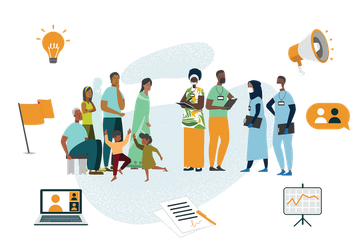Overview of Risk Communication and Community Engagement (RCCE)

Risk communication is sharing information that helps improve the health of communities. This empowers people to adopt health behaviours that keep them safe. Community engagement is working with community members, leaders and organizations to plan and implement activities that improve the health of the community as a whole. 🔊🤝🏽✔
RCCE improves the health of whole communities. It builds community systems to share and discuss the health information 📚 and advice they need to take action. It builds shared understanding, considers each community's situation and creates the opportunity for the community to engage with each other to improve public health work. As COVID-19 is new and information changes over time, RCCE reduces confusion, supports public health work (like disease surveillance and contact tracing) and prevents outbreaks.
The Key Elements of RCCE
As a community health worker you can help your team to develop RCCE plans ✍️ that are relevant to your community by sharing your knowledge of your community. Share how your community communicates, their day-to-day habits and their COVID-19 beliefs and behaviours. This will ensure that RCCE plan successfully encourages the community to adopt behaviors that will prevent the risk of disease and illness.
RCCE plans have objectives, messages, target audiences, activities, monitoring plans, community engagement plans and a budget.
Core Standards of RCCE
Community health workers play an important role in implementing RCCE plans in the community. Follow these 6 standards for good Community Engagement:
- Participation: Involve community members in the planning and implementation of local activities. Use what the community tells you about their needs to inform the way you implement activities.
- Empowerment and Ownership: Community members are given opportunities to own and be empowered when implementing activities in their own community.
- Inclusion: Vulnerable groups in the community are identified and supported to take part in the activities. Consider populations that are under-represented, disadvantaged, and/or marginalized.
- Two-way Communication: Community members both give and receive regular communication. This encourages communities to seek out information and participation in all activities.
- Adaptability and Localization: Activities are developed according to the local context and environment. This ensures community members’ specific needs and concerns are addressed.
- Building on Local Capacity: Local activities should build upon the existing resources and capacity of the community.


